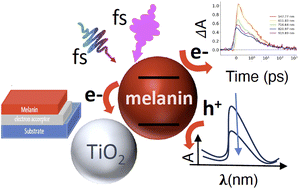Enhanced photochemical activity and ultrafast photocarrier dynamics in sustainable synthetic melanin nanoparticle-based donor–acceptor inkjet-printed molecular junctions†
Abstract
Melanin is a stable, widely light-absorbing, photoactive, and biocompatible material viable for energy conversion, photocatalysis, and bioelectronic applications. To achieve multifunctional nanostructures, we synthesized melanin nanoparticles of uniform size and controlled chemical composition (dopamelanin and eumelanin) and used them with titanium dioxide to fabricate donor–acceptor bilayers. Their size enhances the surface-to-volume ratio important for any surface-mediated functionality, such as photocatalysis, sensing, and drug loading and release, while controlling their chemical composition enables to control the film's functionality and reproducibility. Inkjet printing uniquely allowed us to control the deposited amount of materials with minimum ink waste suitable for reproducible materials deposition. We studied the photochemical characteristics of the donor–acceptor melanin–TiO2 nanostructured films via photocatalytic degradation of methylene blue dye under selective UV-NIR and Vis-NIR irradiation conditions. Under both irradiation conditions, they exhibited photocatalytic characteristics superior to pure melanin and, under UV-NIR irradiation, superior to TiO2 alone; TiO2 is photoactive only under UV irradiation. The enhanced photocatalytic characteristics of the melanin–TiO2 nanostructured bilayer films, particularly when excited by visible light, point to charge separation at the melanin–TiO2 interface as a possible mechanism. We performed ultrafast laser spectroscopy to investigate the photochemical characteristics of pure melanin and the melanin–TiO2 constructs and found that their time-resolved photoexcited spectral patterns differ. We performed singular value decomposition analysis to quantitatively deconvolute and compare the dynamics of photochemical processes for melanin and melanin–TiO2 heterostructures. This observation supports electronic interactions, namely, interfacial charge separation at the melanin and TiO2 interface. The excited-state relaxation in melanin–TiO2 increases markedly from 5 ps to 400 ps. The results are remarkable for the future intriguing application of melanin-based constructs for bioelectronics and energy conversion.

- This article is part of the themed collections: U.S National Nanotechnology Day 2023 and Nanomaterials for printed electronics


 Please wait while we load your content...
Please wait while we load your content...
